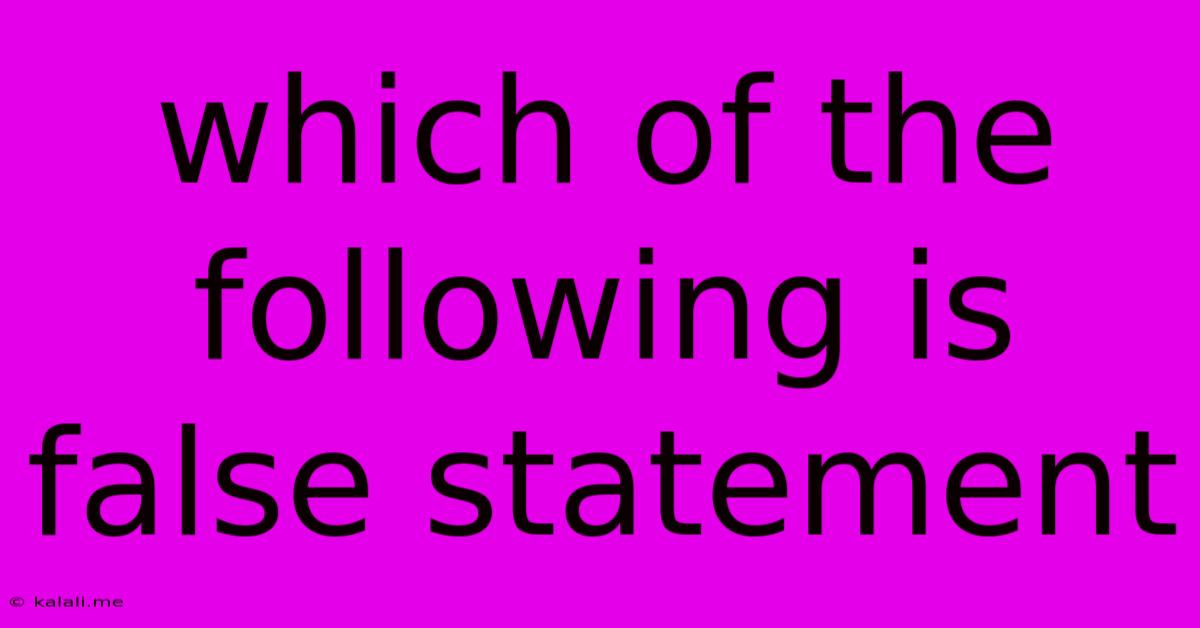Which Of The Following Is False Statement
Kalali
Jun 15, 2025 · 3 min read

Table of Contents
Identifying the False Statement: A Critical Thinking Exercise
Identifying false statements is a crucial skill, vital for everything from everyday decision-making to advanced academic pursuits. This ability requires careful reading, logical reasoning, and a healthy dose of skepticism. This article will explore the process of identifying false statements, offering strategies and examples to improve your critical thinking skills. We'll also look at common pitfalls to avoid when evaluating information.
This article aims to help you understand the nuances of identifying false statements, whether they are presented in multiple-choice questions, complex research papers, or everyday conversations. We will cover common types of false statements, strategies for detecting them, and the importance of verification. By the end, you'll be equipped with the tools to confidently discern truth from falsehood.
Understanding the Nature of False Statements
A false statement, simply put, is a claim that is not true. However, identifying a false statement often goes beyond simply knowing the facts. It requires evaluating the logic, evidence, and context surrounding the claim. A statement might be false due to:
- Factual Inaccuracy: The statement presents information that is demonstrably untrue. For instance, claiming "The Earth is flat" is factually inaccurate.
- Logical Fallacies: The statement uses flawed reasoning, even if the individual components might be true. Examples include straw man arguments, appeals to emotion, and false dilemmas.
- Misleading Information: The statement omits crucial details or presents information in a way that is deceptive or manipulative. This can involve cherry-picking data or using loaded language.
- Contradictions: The statement contradicts itself or other established facts.
Strategies for Identifying False Statements
When faced with a statement you suspect might be false, employ these strategies:
- Verify Information: Cross-reference the statement with multiple reliable sources. Don't rely on a single source, especially if it has a known bias. Consult encyclopedias, academic journals, reputable news outlets, and government websites.
- Analyze the Source: Consider the credibility of the source. Is it an expert in the relevant field? Does the source have a history of accuracy? Be wary of anonymous sources or sources with a clear agenda.
- Look for Logical Fallacies: Learn to identify common logical fallacies. Understanding these fallacies will help you spot weaknesses in arguments and identify potentially false statements.
- Identify Bias: Be aware of potential biases in the information presented. Consider the perspective of the author or source and how it might influence the information.
- Check for Context: Consider the context in which the statement is made. A statement that is true in one context might be false in another.
- Break Down Complex Statements: If the statement is complex, break it down into smaller, more manageable parts. Examine each part individually to determine its truthfulness.
Examples of False Statements and How to Identify Them
Let's examine a few examples:
Example 1: "All swans are white."
This statement is false. While many swans are white, black swans exist, disproving the universality of the claim.
Example 2: "The sun rises in the west."
This statement is demonstrably false. The sun rises in the east and sets in the west.
Example 3: "Eating chocolate causes acne."
This statement is a simplification. While some studies suggest a correlation, it's not a direct causal relationship. More research is needed to definitively prove this claim. This exemplifies the importance of considering the nuances of evidence.
Conclusion: The Importance of Critical Thinking
Identifying false statements is a fundamental aspect of critical thinking. It's a skill honed through practice and a commitment to seeking truth. By employing the strategies outlined above, you can significantly improve your ability to evaluate information critically and make informed decisions based on reliable facts. Remember to always be skeptical, verify information from multiple sources, and consider the context and potential biases involved.
Latest Posts
Latest Posts
-
What Type Of Slope Failure Is Shown In This Figure
Jun 15, 2025
-
Differentiate Between Short Run And Long Run
Jun 15, 2025
-
What Is The Difference Between An Entrepreneur And Entrepreneurship
Jun 15, 2025
-
Which Of The Following Is A Nonrenewable Energy
Jun 15, 2025
-
Is An Alloy A Heterogeneous Mixture
Jun 15, 2025
Related Post
Thank you for visiting our website which covers about Which Of The Following Is False Statement . We hope the information provided has been useful to you. Feel free to contact us if you have any questions or need further assistance. See you next time and don't miss to bookmark.